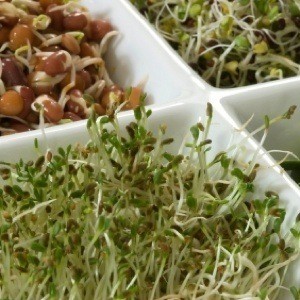Growing vegetable sprouts is fun, economical, and easy to do yourself. Not only are sprouts delicious, but they are also packed full of nutrients like protein, fiber, and vitamin C. Here are two quick and easy ways to sprout vegetable seeds at home, one using the traditional jar method, and the other using a cookie sheet.
Most everyone is familiar with bean and alfalfa sprouts, but sprouts can be grown from a variety of seeds including lentils, soybean, peas and chickpeas, celery, radish, broccoli, cabbage, and sunflowers. Grass seed like rye, barley, wheat and buckwheat are also popular for sprouting, and like your lawn, will continue to grow and produce a second crop after being cut.
When choosing seeds for sprouting, look for organic seeds that have not been treated with chemical preservatives. These can be found in health food stores, in catalogs, or online. Different seeds produce sprouts with very distinctive flavors. If you're unsure about what to try, many companies offer sampler packs that include several different types of their most popular seeds.
Materials Needed:
Sprouting lids are available that are designed to fit Ball Mason jars for a cost of around $4.00. Look for them at grocery stores, health food stores or you can order them online. The advantage to using them is that they allow for convenient drainage while also providing good air circulation so the seeds can breathe. I recommend getting the plastic mesh lids instead of steel mesh, which have a tendency to rust around the edges.
Directions:
Tips:
Without proper air circulation and drainage, the moist, humid environment of a sprouting jar can encourage mold and bacteria to growth. For this reason, some people may prefer the cookie sheet method, which allows the sprouts to grow vertically in the open air rather than in a tangled clump. This is also a good method for tiny seeds that are difficult to strain.
Materials Needed:
Directions:

About The Author: Ellen Brown is an environmental writer and photographer and the owner of Sustainable Media, an environmental media company that specializes in helping businesses and organizations promote eco-friendly products and services. Contact her on the web at http://www.sustainable-media.com
Add your voice! Click below to comment. ThriftyFun is powered by your wisdom!
Ellen,
This is so timely! I haven't been able to find the multi-sprouts at my grocery lately. They're limited to alfalfa sprouts only. I'm going to take your tips and hope to enjoy fresh sprouts on our salads.
Thank you.
Laura
This article should have included photos of all methods. A picture is worth a thousand words. And the author is actually a photographer!
Add your voice! Click below to comment. ThriftyFun is powered by your wisdom!